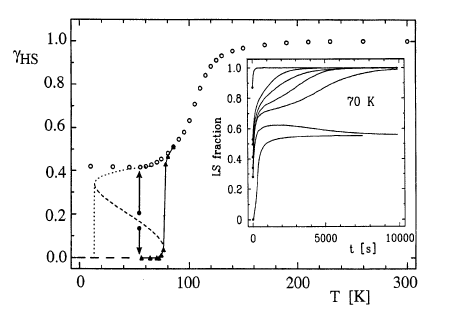
|
Photophysics and Photochemistry of Transition Metal Compounds |
| Home Research Members Collaborations Publications |

|
||||||||
Short range correlations of the distribution of high spin (HS) and low spin (LS) states show up in thermal spin transition curves, decay curves of the light induced metastable HS state (LIESST state), and in structural features during the spin transitions. Correlations are due to short range interactions between the spin crossover molecules. Short range interactions may compete with omnipresent long range interactions and give rise to interesting spin transition phenomena. In this paper, the effect of correlations on the thermal spin transition in the mixed crystal system [FexZn1−x(pic)3]Cl2·EtOH (pic=picolylamine) is discussed. In particular the step in the thermal transition curve is a direct consequence of such correlations. In addition, the decay of the metastable HS state of the pure iron compound at ca. 20 K can be significantly changed by preparing metastable HS states with a random distribution over the lattice sites. Both experiments could be well reproduced by Monte Carlo simulations. In the orthorhombic modification of the compound Fe[5NO2-sal-N(1,4,7,10)]([2,2′-(2,5,8,11-tetraazadodeca-1,11-diene-1,12-diyl)4-nitrophenolato] (2-)-N2, N2′,N2′′,N2′′′,O1, O1′]Fe(II)) a commensurable superstructure has been found. This compound represents the first example of a stable infinite range correlation of the spin states over the lattice sites. | ||||||||
|
 |
|||||||
In iron(II) spin-crossover compounds, the transition from the 1A1 low-spin state at low temperatures to the 5T2 high-spin state at elevated temperatures is accompanied by a large increase in metal-ligand bond lengths. The resulting elastic interactions may be pictured as an internal pressure which is proportional to the concentration of the low-spin species. Because pressure stabilises the low-spin state relative to the high-spin state this results in a positive feedback. Thermal transition curves in neat iron(II) spin-crossover compounds are thus invariable much steeper than in diluted mixed crystals, and the high-spin→low-spin relaxation following the light-induced population of the high-spin state at low temperatures is self-accelerating. Strong interactions give rise to a thermal hysteresis, and light-induced bistabilities may be observed for compounds with initially a high-spin ground state and the potential for a light-induced population of the low-spin state. For such compounds, the increasing internal pressure may stabilise the low-spin state sufficiently so that it becomes the molecular ground state above some critical light-induced low-spin fraction. Secondary effects of the elastic interactions include crystallographic phase transitions, inhomogeneous distributions of sites, and anomalies such as steps in the transition curve. | ||||||||
|
||||||||
The spin-crossover compound [Fe(pic)3]Cl2EtOH (pic = 2-picolylamine) shows an unusual two-step spin transition. This is thought to be caused by specific nearest-neighbour interactions and short-range correlations and requires a theoretical treatment of the elastic interactions between the spin-changing molecules beyond the mean-field approximation. Such short-range correlations also influence the high-spin → low-spin relaxation following the light-induced population of the high-spin state at cryogenic temperatures, leading to characteristic deviations from the predictions of a mean-field treatment. These deviations are directly observable by comparison of the full and unperturbed relaxation curves with curves for which the short-range correlations were destroyed using an appropriate irradiation technique. Monte Carlo simulations including both nearest-neighbour and long-range interactions give a description of the observed relaxation curves which is consistent with the thermal spin equilibrium. | ||||||||
|
||||||||
In the [Fe(ptz)6](BF4)2 (ptz = 1-propyltetrazole) spin-crossover system, the thermal spin transition is accompanied by a first order crystallographic phase transition (Tc↓ = 128 K and Tc↑ = 135 K) from R3 above Tc↓ to P1 at low temperatures (Wiehl L., Acta Cryst. B49, 289 (1993)). The high-symmetry phase can be super-cooled, in which case the spin transition is still complete and quite steep (T1/2 = 125 ± 2 K) but now without a hysteresis. The corresponding interaction constant Γ is 170 cm−1. In the diluted system [Zn1−xFex(ptz)6](BF4)2, X = 0.1, the spin transition is gradual with T1/2 = 95 ± 2 K. From the shift of T1/2 towards high temperatures with external pressure a value for ΔVHL0 of 26 Å3 molecule−1 is obtained. Pressures above 250 bar induce a crystallographic phase transition even in the diluted system, as a result of which the spin transition is discontinuous. The interplay between the thermal spin transition and the crystallographic phase transition in the neat and the diluted system is discussed consistently. | ||||||||
Download this list in format RIS
 EndNote
EndNote  BibTex
BibTex  PDF XML
PDF XML Last update Friday December 08 2017